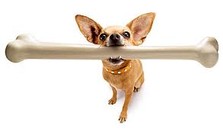Bones - Midcoast Animal Hospital
Main menu
- Home Page
- About Us
- Meet The Team
- Testimonials
- Dog Articles
- Cat Articles
- Cruciate Surgery
- Puppy Preschool
- News
Bones
Feeding raw bones to dogs
Background:
Eating raw bones is as completely natural as eating fresh meat for dogs and cats. They come hand in hand, in the wild. Both dogs and cats are natural hunters, cats always eating their food fresh, and dogs happy to eat fresh, or decaying. Either way, catching and eating prey has always involved the consumption of bones. Feeding bones to domestic dogs has been a time honoured tradition, and is still practised by knowledgeable dog breeders and pet owners. The feeding of bones to cats has had less emphasis in the past, as cats have always been able to catch and eat their own prey, complete with bones. Since the advent of “ready to serve” commercial pet foods, there has been a noticeable decline in the practice of feeding bones to dogs by many pet owners, particularly raw bones. And now that the modern domestic cat’s natural hunting abilities have been limited bytheir confinement, there is a marked decline in the consumption of raw bones by cats also.
always been able to catch and eat their own prey, complete with bones. Since the advent of “ready to serve” commercial pet foods, there has been a noticeable decline in the practice of feeding bones to dogs by many pet owners, particularly raw bones. And now that the modern domestic cat’s natural hunting abilities have been limited bytheir confinement, there is a marked decline in the consumption of raw bones by cats also.
Benefits:
Raw bones are consumed first and foremost for their nutritional value to the cat or dog. A natural, and highly digestible source of calcium is provided by raw bones, and is required to provide a natural balance to the higher levels of phosphorous found in raw meat.
Adequate calcium is vital for normal growth and development, for correct mineralisation (strength) of the teeth and bones, and structure of joints. It is vital for muscular contraction in the body, including the heart muscle, and is involved in a wide array of metabolic processes. The calcium in raw bones can be up to 4 times more digestible than most common calcium supplements available. Bones also supply smaller amounts of cartilage, bone marrow, and other minerals, like boron, which are vital for bone health.
Raw bones also play an integral role in dental hygiene for dogs and cats. The process of macerating the meat and bones actually massages the animal’s teeth and gums, cleaning away any food residues or tartar development. This prevents plaque formation, bad breath, dental cavities, gingivitis, and expensive veterinary teeth scaling and extractions. A good supply of calcium and other nutrients during the early growth stages of puppies and kittens will also help to ensure strong healthy teeth.
And finally, a good bone feed actually has a beneficial effect on the dog or cat’s digestive tract. It has a cleansing / scouring effect, providing much needed roughage in the diet, and provides bulk for healthy faecal motions that stimulate anal gland emptying.
Why raw:
The benefits of eating bones are greatly reduced by cooking, and it can actually create dangers. Cooking bones renders the natural calcium almost unavailable for absorption, losing that vital source of mineral availability. Cooked bones are much tougher, and more brittle than raw bones, and will actually blunt an animals teeth after regular chewing. They also break into large chunks more easily, and can result in your pet swallowing a piece too large to digest, and then a quick visit for some veterinary attention. Cooked bones are very slow to breakdown in the animals gut, and can cause gut pain (colic), scarring of the gut lining and bleeding, and can lead to constipation
Bones for Dogs:
The basic guide for choice of bones is really decided by the size of the dog. Large dogs can handle larger bones, like lamb necks, lamb shanks, beef leg bones, whole rabbit, whole chickens or chicken carcasses, kangaroo tails. Smaller dogs will fare better with chicken frames, chicken necks or wings, lamb flaps, brisket bones, ribs etc. My favourites are roo tails.
Remember that there are two distinct types of bones; those that are eaten easily and quite quickly, are nutritional, and provide all of the above listed benefits. Bones that are too large or tough, and end up scattered over the back yard, or buried in the lawn, and dug up or chewed on over many days, are more of a “toy”.
They offer some dental hygiene effects, but minimal nutritional effect.
They do however, keep many a dog happy for several hours a day.
Try and get bones with some meat left on, as it encourages the dog to exercise the front incisor teeth while tearing at the meat. This is very important during puppy-
How often:
Puppies and kittens should have a bone offering every day during their growth phase. For cats and small breed dogs, this ends around 6-
What to avoid:
Avoid cooked bones full stop. As a general rule, avoid bones of a size that will tempt the dog to swallow them without chewing..they can still get caught in the gut, or wedged across the roof of the mouth. Although whole raw bone will digest slowly, it does not yield as much health value to the dog, as a well-
We hope this hand-